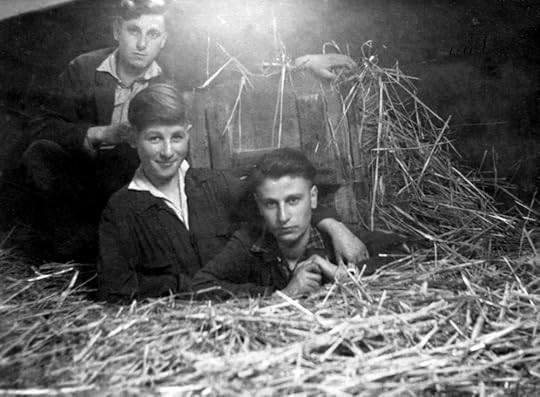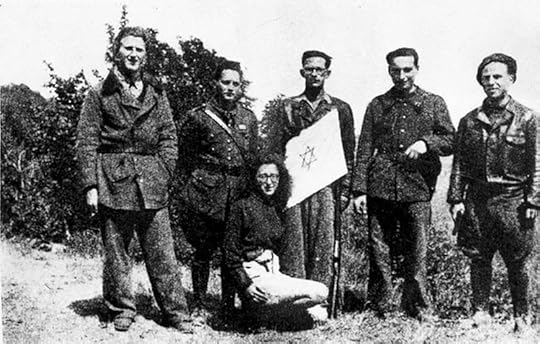Why did Holland have the highest number of Jewish victims during WW2. Part 3

Three Jewish brothers hiding in a barn in rural Holland
In the first blog post, I explained the differences between Holland, Belgium, and France regarding their Jewish populations and the governments that were put into place after the German occupation in 1940. In the second post, I explored the Dutch situation in more depth.
In part 3 we get the answer why Holland had the highest number of Jewish victims per capita.
My next book in The Resistance Girl Series, The Crystal Butterfly, which comes out on 6 July, is based on a fictive story of the lamentable Jewish situation in Holland during World War Two.
Deportations in the Netherlands
When deportations began in all three countries in July 1942, it turned out that the German police in the Netherlands had almost complete control over these transports, largely outside the rest of the occupation administration and the Dutch authorities. This was to a lesser extent the case in Belgium and did not apply to France. For the Dutch situation it meant the Germans extensively used deception to execute the deportations. For example, they provided tens of thousands of provisional exemptions (a so-called Sperre), only to withdraw them step by step later.
All Dutch Jews had been meticulously registered in a chart room. Tragically, with the help of the data the Joodsche Raad (Jewish Council) had collected. This allowed the Germans to take apart parts of Dutch Jewry without resistance or much hiding.
The German police managed to remove the Jewish population without this leading to much hiding or resistance. The Germans called this secret rounding up in stages Stufe Nacht und Nebel (Operation Night and Fog). Adolf Eichmann, who organized the deportations of the Jews throughout Europe from Berlin, was satisfied and spoke these horrific words: the trains from the Netherlands 'rollten am Anfang, dass man sagen kann, es war eine Pracht' ('rolled in the beginning, that one can say, it was beautiful').
From January 1942, an increasing number of Jewish men had been sent to labor camps within the Netherlands. When the deportations started in July of that year, these men thought they wouldn’t have to go to Poland, as they were already employed. In early October 1942, these men, together with their families, (over 12,000 people) were arrested in one big razzia and almost all of them directly deported to Auschwitz.
The same was true for the Jewish hospitals, orphanages, and homes for the elderly. Apparently, being left alone by the German police for months, many believed they were still safe. From January 1943 onwards, these places were evacuated one after the other. As with the labor camps, these groups were an easy prey for the occupiers because of isolation and concentration beforehand.
In 1942, the German occupation authorities and their Dutch, French and Belgian collaborators expelled Jews systematically and almost without exceptions: first from Amsterdam, then from Antwerp, and finally from Brussels and all other European cities.
In France, the German occupiers failed to achieve these first deportations there because of logistical issues and lack of local control. Most Jews from northern France could leave and escape to neutral countries. Several joined the French Resistance.

Arrested Jews in Belgium
The raids in Belgium
The German police mercilessly chased down and arrested Jews who were still living in Belgium, mostly in Antwerp and Brussels. But many had wisely left Belgium. About 75% of the remaining Jewish population was taken to concentration camps and death camps. Those that remained tried out their luck at hiding or mingled with the non-Jewish population to escape detection by the occupying forces, who had seen an over 50% reduction in the number of Jews living in Belgium after just two years there. The mostly Eastern European background of the Jews played a role in this: they had already fled anti-Semitism in their native country and knew both the methods and the horrific consequences of the persecution.
The French Vichy government and the persecution of Jews
The Dutch and Belgian governments had little to no influence over the occupier’s anti-Jewish policy in 1941. The Vichy government in France, though, played a significant role in the deportations. Thanks to them, the Germans could deport more Jews than they would have if they’d worked alone.
The French police arrested two out of three deported Jews and handed them over to the Germans. In Holland this was almost one in our and in Belgium almost one in six. The difference between Holland and Belgium can partly be explained by a larger share of arrested Jews in Holland who were then handed over to the Germans by members of their own country's police force.
From October 1942, the French government refused to continue to arrest Jews on a large scale and extradite them for deportation. This was mainly because of violent protest from churches and communities, especially in that part of France not occupied by Germany.
The American pressure behind the scenes also contributed to this decision by the French side from October 1942 onwards: firstly because Roosevelt made his disapproval clear at various points throughout 1943; secondly owing to simultaneous pressure exerted upon Spain; and thirdly because successive victories by Allied soldiers on land also brought closer capture (and hence occupation) by Nazi forces–meaning that living conditions would deteriorate
All this caused prolonged interruptions in the deportations in France. In short, the opportunistic role of the Vichy government initially aggravated the situation of the Jews in France, but because of the protests, changing circumstances and the growing resistance groups, fewer French than Dutch Jews would eventually be deported.

Jewish Resistance Fighters in France
Resistance, hiding and helping Jews
In Belgium and France, the organized resistance sprang up earlier than in Holland. The help to Jews citizens in need of hiding or escaping also began sooner. In October 1942, general and compulsory employment for Belgian and French men in German factories was introduced. This measure caused such a shock effect that many of them went into hiding or resisted.
Slumbering Jewish resistance and hiding coincided with this measure, so Jews joined in the organized resistance from the start of the deportations. However, the French and the Germans used snitchers, who’d receive monetary rewards for bringing in Jews.
In Holland, the violent suppression of the 1941 February strike deterred most Dutch resisters for over a year. Networks of hiding only emerged after the 1943 Spring strikes, when compulsory employment of dutchmen in Germany was increased. By then, most Dutch Jews had already been deported.
Numbers of victims
Of the over 30,000 Dutch Jews who went into hiding or attempted an escape abroad, about a third–sometimes after years of hiding–were betrayed or discovered and taken away, including the Frank family.
Holland had 102,000 Jewish victims and 107,000 deportees. Another 2000 Dutch Jews committed suicide or were killed or died in German captivity on Dutch territory: Camp Amersfoort, Camp Vught, Camp Westerbork, Ellecom, German prisons in the Netherlands.
These numbers also include Jews who died in hiding or who tried to escape to other countries and were caught or died in transit.

Victims of Razzia in Amsterdam May/June 1943
Number of people in hiding30,000 Jews were trying to escape the German claws by going into hiding. 2,000 of those tried to escape abroad. Of the 28,000 Jews hiding inside Holland, some 12,000 were arrested, which is more the 42%.
However, not all of these were betrayed by snitchers. Some 12,000 of those were deported because they had trespassed a so-called criminal law (not pertaining to curfew, not wearing the Star of David, or wearing it incorrectly, traveling without a valid travel permit, shopping outside Jewish shopping hours.)
The estimate is that about a third of the 30,000 Jews who first managed to first evade the deportations by going into hiding were eventually betrayed. Which is a sickening number. I don’t know what else to conclude.
Preorder The Crystal ButterflyBased (among others) on information by historians Pim Griffioen and Ron Zeller, authors of ‘Persecution of the Jews in the Netherlands, France and Belgium, 1940–1945: similarities, differences, causes’



